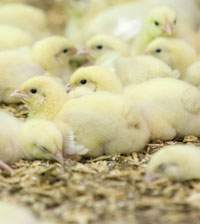EU could enforce targets for reducing campylobacter levels

The UK broiler industry could soon face EU targets for reducing campylobacter levels in birds, similar to that seen with salmonella.
This was a key message from a food safety seminar hosted by the British Poultry Council in London.
Campylobacter accounted for more than four times the number of food poisoning cases last year in the UK. And as Food Standards Agency (FSA) chief executive Tim Smith pointed out, half of those investigated were traced back to poultry.
He said that future EU control plans were on the horizon and they could be like those aimed at salmonella with specified reduction targets. “We need to be prepared for that.”
This is why the FSA has spent the past few years working with researchers and the UK poultrymeat sector in tackling campylobacter with a target of halving it by 2010 in UK retail chicken. Last year, DEFRA spent £800m on research.
Part of this was a review of current published data carried out by Diane Newell, of the Food Borne Zoonoses Consultancy. She highlighted the lack of quality data.
What few estimates there are suggest prevalence varies from 45% to 90% of flocks colonised by the time of slaughter depending on the time of year. However, she added that the results of an EU-wide survey were due to be published later this year, which will establish a baseline figure for the UK sector.
One key message from research is that the risk falls 30-fold if you have a 2 log reduction in the numbers of campylobacter on chicken carcasses, “therefore, you don’t need to eliminate it to see a significant reduction in risk to consumers.”
Looking at how the disease behaves, data shows that birds typically remain campylobacter free for the first 2-3 weeks of life. Therefore, Prof Newell suggested that one option could be to move forward the time of slaughter, as done in Scandinavia. Fewer birds would be infected by slaughter.
However, Dan Pearson of Vion UK questioned whether consumers would accept chickens only being reared to 35 days. He also highlighted that freezing was part of the Scandinavian approach and the UK couldn’t move to frozen chicken only, as there was a substantial market for “fresh poultry”.
Looking at potential sources, Prof Newell said there was growing evidence the main source is other broilers, with cattle, sheep and wildlife to a lesser extent. “Most are circulating in poultry, therefore moving between flocks.”
Sequential studies suggest 20% flock colonisation is from the previous flock, showing that most infection is from external sources. People and equipment seem to be the biggest transmission route.
So how can producer reduce prevalence? Kathryn Callaghan of the FSA pointed to research showing that “enhanced biosecurity can help cut flock positives by 50%.” And this costs £3 a house.
She then outlined a mini survey of eight farms across three companies, revealling shortcomings. “Only one of the three companies used dedicated boots and there were issues with boot dips.” These included the wrong disinfectant concentration and inappropriate containers.
“Two out of the eight farms had difficulties with keeping pets away from poultry houses,” she said.
Mr Pearson acknowledged that biosecurity can help, but he added that the UK sector had a high standard when compared with other farming sectors and poultry industries in other countries and had a good record on endemic diseases like Gumboro.
He questioned: “Are we talking about a step change for example employing [biosecurity] practices seen on farms higher up the breeding pyramid.”
Even with good biosecurity, Prof Newell said that it was becoming more obvious that these measures alone won’t lead to significant reductions. Complimentary measures are needed.”
These additional measures include vaccinating birds, using bacteriophages, competitive exclusion products or post harvest decontamination in plants. However, more work is needed to assess their possible effectiveness.
